Origin Overviews is a series of reference articles on prominent coffee regions written by editor-in-chief Kenneth Davids. They are posted regularly in Coffee Review and will appear in print form in Kenneth Davids’ latest comprehensive book on coffee.
This Origin Overview focuses on the regions clustered around the African Great Lakes region, and supports our June 2018 tasting report, “African Great Lakes Coffees: Burundi, Rwanda, Uganda, Congo, Tanzania.”
Rwanda and Burundi: Conflict and Achievement
Rwanda and Burundi are small, landlocked countries nestled in the heart of Africa in the region of the African Great Lakes. Although their specific histories differ, they share commonalities both as coffee origins and as societies.
- Both are small countries with problematic histories that nevertheless produce very good, very interesting specialty coffees
- Both have high average growing elevations and excellent coffee terroirs
- Both have large plantings of old, traditional tree varieties related to the admired Bourbon variety
- Both countries share a famous regional coffee taint – the infamous “potato defect,” the unmistakable and quite unpleasant scent and taste of raw, sprouted potato
- Both countries – along with neighboring Uganda and the eastern region of the Democratic Republic of the Congo – suffer ongoing political and economic competition and resulting conflict between the Hutu and Tutsi, groups that share the same language and roughly the same culture but, for historical, economic and class reasons, identify as different peoples. Political and economic competition between the two has given rise to bloody conflicts that have both hampered and, in the case of Rwanda, sadly but spectacularly helped in the development of high-end specialty coffees.
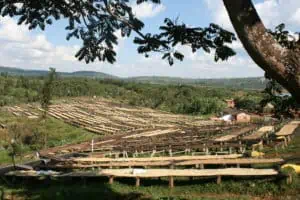
Raising drying beds, typical of coffee production in the African Great Lakes region. Courtesy of James Viljoen.
Conflict in Burundi: Off, and then On Again. In Burundi the Hutu-Tutsi tensions erupted in series of regime changes and massacres culminating in a bloody civil war in 1993-2005. From the end of that conflict until 2015 Burundi has been more or less at peace, largely producing better and better coffees. Pierre Nkurunziza, a former Hutu rebel leader, became the first president to be chosen in democratic elections since the start of Burundi’s civil war in 1994. But in 2015 Burundi was plunged into its worst crisis since the end of the civil war in 2005, when President Nkurunziza’s ultimately successful bid for re-election to a third term sparked protests by opposition supporters who said the move was unconstitutional. At this writing this political crisis continues. Hopefully it will not threaten Burundi’s accelerating coffee comeback.
Genocide and Revival in Rwanda. Meanwhile, in 1994 in neighboring Rwanda, the genocidal killing by Hutus of 500,000 to 1,000,000 mainly Tutsis shocked the world and pushed international development agencies into an urgent search for ways to bring economic growth and social healing to Rwanda. They found it in Rwanda’s potential for producing high-end specialty coffee: in its Arabica-friendly terroirs, traditional tree varieties celebrated for their distinctive cup character and small-holding, hard-working coffee farmers. Before the genocide and the international reaction, Rwanda was a source of inexpensive coffees carelessly prepared for a largely commodity market. Within a few years after the end of the conflict, development agencies, with significant help from specialty-coffee roaster and importer volunteers, developed a coffee infrastructure that liberated the quality potential of the traditional local tree varieties and their high-elevation terroirs by introducing centralized wet-processing and training in quality-enhancing practices. In just a few years, Rwanda graduated from minor, overlooked supplier of commodity coffee to an admired source for distinctive specialty types.
In recent years there has been some weakening of coffee consistency and signs of renewed political tension in Rwanda, but for the moment Rwanda, along with Burundi, continues to produce a range of deeply expressed, resonantly distinctive coffees. We need to hope that coffee continues to win in its struggle to provide a catalyst for social and economic cooperation that will transcend a history of distrust, competition and conflict in the region.
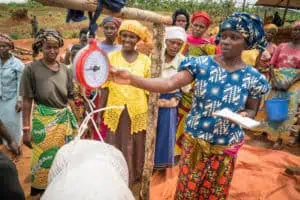
Farmers of the Twongere Umusaruro Cooperative weighing their crop, Rwanda. Courtesy of Sustainable Harvest.
The Traditional Rwanda and Burundi Cup
Typical Global Descriptors. The best specialty Rwandas and Burundis are almost always sweet and balanced (vivacious but not overbearing in acidity; lightly syrupy or satiny in mouthfeel), engagingly and resonantly complex, often with unusual and engaging herb, vegetable or generally savory suggestions. The bracing juxtaposition of lush sweetness and pungent, savory tartness characteristic of the great Kenya coffees shows up in many Burundis and Rwandas, but rounder, with less intensity than in Kenyas. On the downside, some Rwandas at this writing show flat, woody tendencies which may be owing to poor drying practices or delays in transport from this landlocked country.
Typical Aroma/Flavor Descriptors. Sweet but quiet flowers (can read as honey), stone fruit, ripe citrus (often tangerine), crisp roasted cacao nib or cocoa, sometimes tartly sweet berry (black or red currant), sometimes musky florals, sometimes deep-toned wood (oak, redwood), occasionally starchy, root-vegetable undertones.
Typical Terroirs. High elevations.
Tree Varieties. Most of the best Rwanda and Burundi coffee is produced from trees of various local cultivars related to the ur-variety of the Great Lakes region, French Mission Bourbon, a mutant selection of the Bourbon variety brought to Tanzania from Reunion (then Bourbon) island near the end of the 19th century. Most common among these Bourbon-related varieties: Jackson, Mibirizi, Mayaguez. All appear capable of displaying some version of the shifty Bourbon profile, from plump, balanced sweetness to a more distinctive juxtaposition of sweetness and tart pungency.
Apparently some of the common Latin-American varieties – Caturra, Catuai – are also grown in Rwanda, but at this writing, hybrids incorporating genetic material from Robusta are not a significant factor in either Rwanda or Burundi, and almost all export coffee comes from trees of local Bourbon-related types.
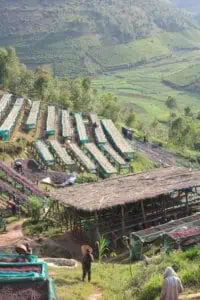
Burundi coffee drying in the whole fruit (“naturals”), in foreground, wet-processed (“washed”) drying in the distance. Courtesy of Oliver Stormshak.
Traditional Processing Methods. For specialty coffees, processing is performed at centralized wet mills or “washing stations” run by exporters or cooperatives using variations on traditional ferment-and-wash methods. These variations may include the two-stage ferment-and-wash procedure often practiced in East and Central Africa, and a final soak in clean water to remove any last fruit residue. After the final soak the beans are temporarily moved to shaded, raised tables for “skin drying.”
The Infamous Potato Defect. During skin drying, workers hover over the tables removing beans damaged by insects or nicked during skin removal. This visual vetting of freshly washed beans is particularly important in the African Great Lakes regions owing the prevalence of the nasty “potato defect,” a powerful local taint that is caused by bacterial invasion of the coffee fruit through breaks in the skin of the fruit that only can be detected by visual examination of the beans while their inner skins are still wet and translucent.
Newer Non-Traditional Processing Methods. For now, it appears that the high-end specialty industries in Rwanda and Burundi are largely standing pat with the best traditional African ferment-and-wash methods, although some experiments with the new styles of natural- or dry-processing (beans are dried in the whole fruit) or honey processing (skins are removed but all or some of the fruit pulp is allowed to dry on the beans) are reaching specialty markets.
Growing Regions
Burundi. Burundi is a small country, about the size of Maryland. The coffee growing regions are clustered in the north-center of the country, from about the middle of the country stretching north to the border with Rwanda (encompassing Gitega, Karuzi, Kayanza, Kirundo, Muyinga, and Ngozi Provinces). Coffees are usually identified by province and by the mill or washing station that produced them.
Rwanda. Is a compact country in which at least some coffee is grown almost everywhere. Rather than region, specialty coffee is more likely to be labeled by names associated with specific wet mills or washing stations and their exporter operators (like the famous Bufcafe) or wet mills operated by cooperatives (Coopac Kabirizi). Nevertheless, these names are regional in nature because the wet mills draw coffee fruit only or mainly from the regions which they serve. But the compact and rather cohesive nature of Rwanda production (similar varieties, processing methods, similar terroirs) together with the selectivity of importers seem to minimize regional differences. Lists of washing stations and their locations and elevations can be found on the websites of some green coffee importers.
Coffee Calendar and Best Times to Buy, Brew and Enjoy. Rwanda and Burundi are both southern hemisphere coffees (harvest about March through July), so allowing time for resting, transport, buying, selling and roast profiling, they are theoretically at their freshest from the roaster in around November through May.
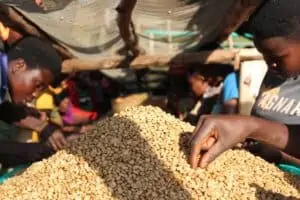
Fighting the “potato defect.” Sorting through freshly wet-processed coffee looking for damaged beans in Burundi. Courtesy of Oliver Stormshak.
Environment and Sustainability
Environment. Rwanda and Burundi both are densely populated countries of small-holding producers (an estimated 500,000 tiny farms in Rwanda and 800,000 in Burundi). There is no larger scale or industrialized agriculture whatsoever. On the other hand, land use is intensive, need for firewood great, and forests have long ago disappeared except where protected. Soil is generally depleted. Nevertheless, the efforts of development agencies and non-governmental agencies working with cooperatives toward organic or other certification has produced some environmental and social success stories. Consumers sensitive to environmental and social issues should look for FTO (fair-trade/organic) certified coffees, which are often outstanding, as fine and distinctive as similar coffees from non-certified producers.
Socio-Economics. Both countries are among the most densely populated and poorest in the world; both depend on coffee as a main producer of income for hundreds of thousands of small-holding farmers. This may be one of the reasons that, at least at this writing, the specialty coffee movement has proved such a successful catalyst for reconciliation and change; in order to profit from higher specialty prices small producers can no longer simply process their coffee any old way at home, but need the collective support of wet mills where collaboration may be essential. Although nothing is perfect, and corruption is inevitable with some wet mill operations, it would nevertheless appear that the “win-win” hypothesis for high-end specialty coffee (consumers pay more for better coffees which then provide better income and greater dignity for small producers) is nowhere as valid and essential as in Rwanda and Burundi.
Read reviews of Burundi coffees.
Read reviews of Rwanda coffees. (Some reviews of coffees from origins bordering Rwanda may also appear in this list.)
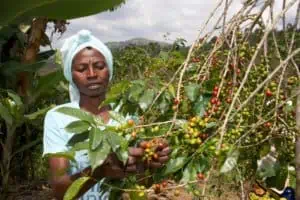
Picking coffee, Hingakawa Women’s Coop, Rwanda. Courtesy of Vournas Coffee and the Hingakawa Coop.
Uganda: High-Grown Robustas and Emerging Arabicas
Uganda is the native home of Coffea canephora, or Robusta. This coffee species, now cultivated across the tropical world, still grows wild in the protected forests of western Uganda. Robusta continues important to Uganda; at this writing, Uganda is the world’s fifth largest producer of coffee from this species. Uganda Robustas are particularly high-grown, and when processed with care rank among the world’s best of their type.
Uganda Arabica Coffees
Uganda also has long produced inexpensive commodity Arabicas, but as a source of better-quality Arabica coffee, Uganda can be seen as a relatively new and emerging origin. Small-holding producers, supported by development agencies and exporter/importers and organized into producer groups or cooperatives, are gradually moving away from anarchic production of carelessly harvested and dried coffees to more disciplined production of better quality coffees processed (usually by the wet or washed method) at centralized mills.
Which is to say Uganda specialty Arabicas are a work in progress, often distinctive and interesting, but frequently lacking the refinement in processing detail that allows their deep, vibrantly sweet/savory structure and syrupy mouthfeel to emerge from behind an often musty roughness.
Bugisu/Sipi Falls Arabicas. Most frequently seen specialty Uganda Arabicas originate on the northwestern slopes of massive Mt. Elgon, near the border with Kenya. Coffees from this region are most frequently marketed as Bugisu, the name of the majority of the people who live in the region and grow the coffee, or as Sipi Falls, the name of a spectacular three-stage waterfall associated with the region. Many of the coffees exported from this region are produced through the Sipi Falls Coffee Project, a successful support project for small holders started in 2000 that draws coffees from thousands of small-scale producers in the region. Other successful cooperatives are also active in the Bugisu/Sipi Falls area.
Other Arabica Regions. Better-quality Arabica is also produced at the opposite, western end of the country near the border with the Democratic Republic of the Congo on the slopes of the Rwenzori mountains. These coffees are sometimes labeled West Uganda coffees. The best – occasionally exceptional – tend to resemble Rwanda and Burundi coffees in profile and also generally are produced by associations of small-holding producers. Finally, still other Arabicas are produced near the northern tip of Lake Albert in western Uganda (“White Nile” coffees) and in the southwestern tip of the country close to the borders with the Democratic Republic of the Congo and Rwanda.
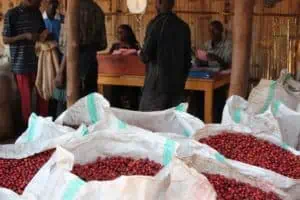
Farmers bringing coffee cherries to a Burundi weighing station. Courtesy of Oliver Stormshak.
A Good Choice for Certified Organic. Most Uganda specialty Arabica coffees are organic-certified, and many carry additional certifications, including fair trade and Rainforest Alliance. Almost all are produced by cooperatives of small-holding producers. Although over the decades Uganda has produced more than its quotient of negative news stories, coffee consumers should keep in mind that the Ugandan leadership generates the headlines, not the over 300,000 small-holding coffee farmers and the three million or so Ugandans who depend on coffee for their livelihood.
Read reviews of Uganda coffees.
The Democratic Republic of the Congo: New Beginning
One corner of the vast Democratic Republic of the Congo (DRC) has recently established itself as a source of fine coffee, most visibly through the development of the SOPACDI cooperative in the far eastern part of the Democratic Republic, across Lake Kivu from Rwanda. At this writing this rapidly growing cooperative has around 6,000 members and apparently is succeeding its goal to help heal wounds left by the latest in eastern Congo’s seemingly endless string of horrific rebellions and civil wars through collaborative production of fine coffee. The cooperative’s coffees typically carry both organic and fair trade certification and can be very attractive coffees in the pungently spicy, sweet/savory African Great Lakes mode. Other cooperatives and grower support projects have been established in the North Kivu region, offering coffees with parallel cup profiles and similarly inspiring stories of social and economic regeneration.
Most DRC Congo North Kivu coffees are produced from trees of locally naturalized strains of the admired Bourbon variety, and processed by traditional wet or washed methods. Some producers are also successfully experimenting with dried-in-the-fruit or “natural” processing.
Read reviews of DRC Congo coffees.
* This material is excerpted from the text of Kenneth Davids’ newest book on coffee, to be published in 2019.










